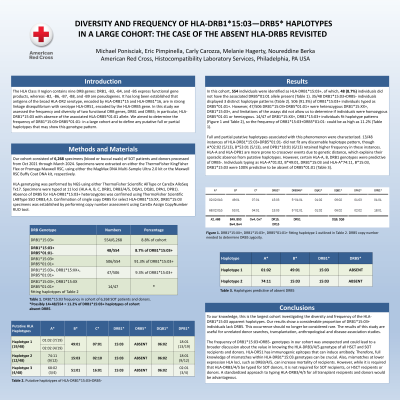Back

Diversity and Frequency of HLA-DRB1*15:03-DRB5* Haplotypes in a Large Cohort: The Case of the Absent HLA-DRB5 Revisited
(P511) Diversity and frequency of HLA-DRB1*15
Location: Platinum Ballroom

Poster Presenter(s)
Aim: The HLA Class II region contains nine DRB genes: DRB1, -B3, -B4, and –B5 express functional gene products, whereas –B2, -B6, -B7, -B8, and –B9 are pseudogenes. In this study we assessed the frequency and diversity of two functional genes, DRB1 and –B5; in particular, HLA-DRB1*15:03 with absence of the associated HLA-DRB5*01:01 allele. We aimed to determine the frequency of DRB1*15:03+DRB5*01:01- in this cohort and to define any putative full or partial haplotypes that may show this genotype pattern.
Method: We performed HLA typing by NGS using One Lambda AllType or CareDx AlloSeq Tx17 on 6,268 SOT samples using DNA extracted from either buccal swabs or whole blood. The absent HLA-DRB5 was confirmed by One Lambda LABType rSSOP. Confirmation of five DRB1*15:XX homozygotes was performed by CareDx CopyNumber(RUO) tool.
Results: 554 individuals of the cohort were identified as HLA-DRB1*15:03+, of which, 48 (8.7%) individuals did not have the associated DRB5*01:01 allele present. 506 (91.3%) of DRB1*15:03+ individuals typed as DRB5*01:01+. However, 47/506 DRB1*15:03+DRB5*01:01+ were heterozygous DRB1*15:XX+, DRB1*15:03+, and limitations of the assays did not allow determination if individuals were homozygous DRB5*01:01 or hemizygous. 14/47 of DRB1*15:XX+, DRB1*15:03+ individuals fit haplotype patterns (Table 1), so the frequency of DRB1*15:03+DRB5*01:01- could be as high as 11.2%.
Based on our large cohort, full and partial putative haplotypes associated with this phenomenon can be characterized.13/48 instances of HLA-DRB1*15:03+DRB5*01:01- did not fit any discernable haplotype pattern, though A*02:02 (5/13) and DPB1*18:01 (6/13) retained higher frequency in these instances.
HLA-A and HLA-DPB1 are more prone to crossover events due to genetic distance, which explains their sporadic absence in putative haplotypes. However, certain HLA-A, B, DRB1 genotypes were predictive of DRB5-. Individuals typing as HLA-A*01:02, B*49:01, DRB1*15:03 and HLA-A*74:11, B*15:03, DRB1*15:03 were 100% predictive to be absent of DRB5*01:01.
Conclusion: To our knowledge, this is the largest cohort ascertaining the diversity and frequency of the HLA-DRB1*15:03 apparent haplotypes. Our results show a considerable proportion of DRB1*15:03+ individuals lack DRB5*. The results of this study are useful for unrelated donor searches, transplantation, anthropological and disease association studies.
Method: We performed HLA typing by NGS using One Lambda AllType or CareDx AlloSeq Tx17 on 6,268 SOT samples using DNA extracted from either buccal swabs or whole blood. The absent HLA-DRB5 was confirmed by One Lambda LABType rSSOP. Confirmation of five DRB1*15:XX homozygotes was performed by CareDx CopyNumber(RUO) tool.
Results: 554 individuals of the cohort were identified as HLA-DRB1*15:03+, of which, 48 (8.7%) individuals did not have the associated DRB5*01:01 allele present. 506 (91.3%) of DRB1*15:03+ individuals typed as DRB5*01:01+. However, 47/506 DRB1*15:03+DRB5*01:01+ were heterozygous DRB1*15:XX+, DRB1*15:03+, and limitations of the assays did not allow determination if individuals were homozygous DRB5*01:01 or hemizygous. 14/47 of DRB1*15:XX+, DRB1*15:03+ individuals fit haplotype patterns (Table 1), so the frequency of DRB1*15:03+DRB5*01:01- could be as high as 11.2%.
Based on our large cohort, full and partial putative haplotypes associated with this phenomenon can be characterized.13/48 instances of HLA-DRB1*15:03+DRB5*01:01- did not fit any discernable haplotype pattern, though A*02:02 (5/13) and DPB1*18:01 (6/13) retained higher frequency in these instances.
HLA-A and HLA-DPB1 are more prone to crossover events due to genetic distance, which explains their sporadic absence in putative haplotypes. However, certain HLA-A, B, DRB1 genotypes were predictive of DRB5-. Individuals typing as HLA-A*01:02, B*49:01, DRB1*15:03 and HLA-A*74:11, B*15:03, DRB1*15:03 were 100% predictive to be absent of DRB5*01:01.
Conclusion: To our knowledge, this is the largest cohort ascertaining the diversity and frequency of the HLA-DRB1*15:03 apparent haplotypes. Our results show a considerable proportion of DRB1*15:03+ individuals lack DRB5*. The results of this study are useful for unrelated donor searches, transplantation, anthropological and disease association studies.

